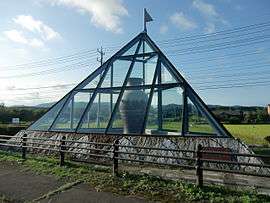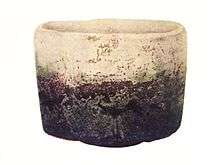Kasama ware

Kasama ware (笠間焼 Kasama-yaki) is a style of Japanese pottery made in Kasama, Ibaraki, Ibaraki Prefecture, Japan. [1]
History
During the mid-Edo period, many potters from the Shigaraki area traveled the country to sell their wares or to simply find employment. During the An'ei period (1772–1784), the headman of Hakoda village in Hitachi Province, Kuno Hanzaemon Michinobe, invited a potter from Shiragaki named Chōzaemon to build a kiln in his village. The new kiln produced plain utilitarian pots and vessels, but soon received the patronage and protection of the daimyo of Kasama Domain, who controlled Hakoda village. This marks the beginning of the style named Kasama-yaki.[2]
During the Meiji period, mass production techniques were introduced and Kasama grew to rival Mashiko as the leading pottery center for the Kantō region. After World War II, as with Mashiko, changes in local attitudes opened Kasama ware beyond its traditional restrictions on form and style, and also opened the industry to any craftsmen, regardless of previous training and background. At present, over 300 potters are known to be active in Kasama, using various types of clay and glazes with no resemblance to the original Kasama ware works of the Edo period.
References
- ↑ Crueger, Annelise; Crueger, Wolf; Ito, Saeko (2007). Modern Japanese Ceramics: Pathways of Innovation & Tradition. Lark Books. ISBN 1600591191.
- ↑ Yellin, Robert. "Kasama-yaki -- Whit Is it?". The Road to Kasama & the Ibaraki Ceramic Art Museum. Japan Pottery Information Center. Retrieved 7 December 2015.
